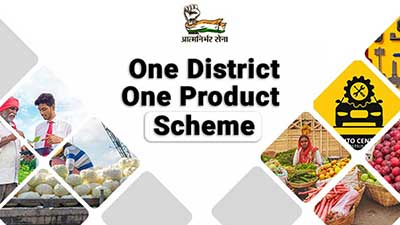Relevance: GS-3: Indian Economy, mobilization of resources, growth, development and employment.
Key phrases: ODOP, NAFED, Atmanirbhar Bharat, DPIIT, MSME, District
Why in News?
- Six brands under the One District One Product scheme were launched on Wednesday. The Food Processing Ministry had inked an agreement with NAFED for developing 10 brands as the One District One Product brands under the Pradhan Mantri Formalisation of Micro food processing Enterprises (PMFME) Scheme.
What is One District One Product?
- One District One Product (ODOP) is an initiative which is seen as a transformational step forward towards realizing the true potential of a district, fuel economic growth and generate employment and rural entrepreneurship, taking us to the goal of AtmaNirbhar Bharat.
- One District One Product (ODOP) initiative is operationally merged with ‘Districts as Export Hub’ initiative being implemented by DGFT, Department of Commerce, with Department for Promotion of Industry and Internal Trade (DPIIT) as a major stakeholder.
- This scheme is basically a Japanese business development concept, which gained prominence in 1979. It is aimed at promoting a competitive and staple product from a specific area to push sales and improve the standard of living of the local population. Over time, it has been replicated in other Asian countries as well.
- One District One Product (ODOP) scheme was initiated in 2018 with a budget of Rs.25,000 crores, by the Government of Uttar Pradesh to revive the indigenous art form by providing financial and marketing support.
- ODOP support the art producers by expanding the industrial world to recreate the lost productive manufacturing and creative process.
Objectives of the Scheme:
- To address and resolve the economic and regional imbalance among the art producers’ community
- To safeguard the traditional knowledge of production and creativity in manufacturing art and craft products
- Create additional MSME sectors in all districts of Uttar Pradesh to increase local art production
- Increase the quality and quantity of local craft production through manufacturing sectors
- Provide a stable marketing platform to improve income, local employment, skills and livelihood
- Develop a common marketing platform between ODOP and tourism sector for live demo sessions and promote the ODOP products as gifts and souvenirs
- Create a marketing platform to promote, design packaging and establishing a brand to increase production and income.
Component under the ODOP Scheme:
ODOP Scheme has four components. They are:
- Common Facility Centre (CFC) Scheme: This scheme would provide financial assistance of up to 90 per cent of the project cost. It is provided by the state government.
- Marketing Development Assistance Scheme: The financial assistance would be provided to all participants of national and international exhibitions and fairs. They can use it for displaying and selling their products selected under ODOP programme.
- Finance Assistance Scheme (Margin Money Scheme): This scheme benefits with not whole but a margin of the project cost. The applicants receive it in the form of subsidy to set up the project.
- Skill Development Scheme: In this, all skilled artisans would be trained through RPL (Recognition of Prior Learning). They would be certified through various Sector Skill Councils, SSCs, whereas the unskilled artisans would be trained for 10 days and provided with an advanced toolkit which will be free of cost
Strategy to Implement the Scheme:
- Organising Sectors: providing specific platforms such as MSME sectors, Co-operative and Self Help Groups (SHGs), the artisans would be able to increase the quality and production of traditional products. This would lead to an increase in income and employment opportunities.
- Creating a specific database: creating database exclusively on finding stakeholders, distribution of products, details on total production and export, raw material requirements and training to make the scheme available to all eligible people.
- MoUs: To increase the skill, quality and productivity, ODOP has collaborated with several sectors such as Quality Control Of India (QCI), National Stock Exchange (NSE), Bombay Stock Exchange (BSE).
- Collaboration: To improve the marketing and promotion ODOP has collaborated with companies such as Amazon, Wipro GE Health Care, small entrepreneurs belonging to textiles, tourism, food processing in India.
- Financial Stability: To provide financial support to the artisans without interruption, the scheme coordinates with MUDRA, PMEGP, Mukhya Mantri Yuva Swarojgar Yojana and Vishwakarma Shram Samman Yojna. This flow of support helps ODOP to provide the required financial support to increase production.
- Marketing: The government of India would collaborate with companies to widen the scope of distribution, increase online promotion and sales activities, advertising and publicity and create a micro plan to export products at national and international products.
- Research and Training: To increase the skills to compete with manufacturers globally, technical and technological training are provided to the Artisans for increased productivity, innovation and research.
Source: The Hindu BL
Mains Question:
Q. Six brands under the One District One Product scheme were launched recently. In the context of this statement discuss what is ODOP? Discuss the strategy to implement the Scheme? Critically examine the challenges that can be faced in its implementation.








